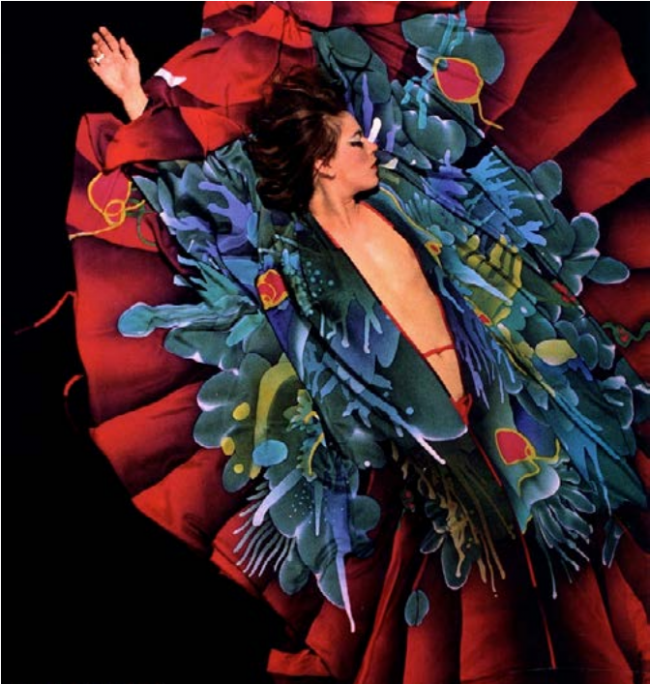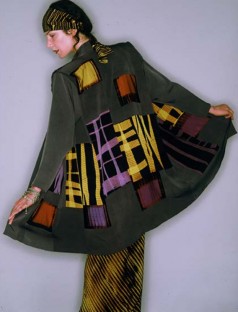Archiving Obiko, Muse of Artwear Movement
April 15, 2016
 Two visionaries who presided over the emergence of the art wear movement (fashion created outside the fashion system) in the 1970s-80s were boutique owners Julie Dale of Julie Artisans Gallery in New York City and Sandra Sakata of Obiko in San Francisco.
Two visionaries who presided over the emergence of the art wear movement (fashion created outside the fashion system) in the 1970s-80s were boutique owners Julie Dale of Julie Artisans Gallery in New York City and Sandra Sakata of Obiko in San Francisco.
Several years ago, some of the Bay Area designers who lived the excitement and energy of that time and movement discussed the need to archive and preserve the influential role Obiko played in it – and in the Bay Area.
Jean Cacicedo and I decided to take on this historical research through Textile Art Council (TAC), the volunteer educational umbrella for the textile department of DeYoung Museum of the Fine Arts Museums of San Francisco. (Thanks to Jean for both collaborating on and suggesting images for this NewsBlog story. -Ed.)
For those unfamiliar with this movement and its muses, the Obiko influence began when Sakata (on right, below) opened her boutique in 1972. It was an alt fashion mecca until it closed in 1997 (when she passed away from beast cancer).

A highpoint of her influence was in 1983, when Obiko was invited into the mainstream fashion world of the prestigious Bergdorf Goodman department store in New York City. It was revolutionary to see Sakata’s style sensibility – expressed by the designers she promoted like Marian Clayden (below) – in BG windows on 5th avenue.

As we began planning the archive, we didn’t know where to begin.
But it seemed logical to contact 24 art wear designers to request digital pictures for a visual gallery. It was very clear that the era of storing yellowing paper reviews, announcements and slides was over. A digital archive was inevitable – and crucial.

Art wear by Kaisik Wong and jewelry by Alex & Lee, Sandra’s close collaborators from the beginning, are well represented in the gallery of photos.
To create a comprehensive overview, we were able to include contributions from well-known representatives of this movement – such as Catherine Bacon, Tim Harding, Candace Kling and Carol Lee Shanks – as well as those lesser known.

Luckily we found a few photographs of Obiko’s iconic windows as well.

We assembled 24 designer bios plus their reflections on the Obiko experience (when available). We included Julie Schafler Dale’s first-person (and East Coast) perspective on the movement, along with that of Pat Henderson, formerly of Bergdorf Goodman.
Art historian JoAnn Stabb also contributed an oral history by interviewing Max Morales, Ariel Bloom, Janet Lipkin (shown below) and Kayla Kennington.

The art wear era was profoundly influenced by ethnic textiles and costumes. Designers felt free to explore and combine these influences. The pictures of Sakata and her windows at Obiko reflect this eclectic Asian aesthetic.

Textile techniques such as Japanese shibori, katazome and roketsuzome were practiced in remarkable new way. Artists such as Carter Smith, John Marshall (shown above) and Ina Kozel (shown below) brought new interpretations of these techniques into visual culture. Though these processes are now part of the international textile vocabulary, they were largely unknown to Americans in the 1980s.

Add hand-weaving, felting, appliqué, piecing, knitting, and hand painting….and the result was a visual, tactile (and wearable) textile bazaar. Sakata had a gift for combining Asian textiles, African-inspired jewelry, indigo cloth from Mali and Native American design references – with flair and style – into cohesive and trend-setting looks.
 Sakata’s fashion shows were the hottest ticket in town during that time. Luckily, Max Morales, who had been music guru for her shows, still had VHS tapes. 4 were chosen to be digitized. We hope to announce access to viewing the fashion shows soon.
Sakata’s fashion shows were the hottest ticket in town during that time. Luckily, Max Morales, who had been music guru for her shows, still had VHS tapes. 4 were chosen to be digitized. We hope to announce access to viewing the fashion shows soon.
First we created an archival “e-book” in a format for CD. Then we realized we wanted the archive to be available, anytime and anywhere. It was inevitable that we employ the 24/7 internet.
It was a challenge to identify and understand the tech tools we needed. To date, the assembled essays and photos that comprise this historical resource are available through Textile Arts Council’s website at www.textileartscouncil.com/obiko-archive/
Our most illuminating discovery was the remarkable extent to which Sakata had been a muse to us all!
It has been very gratifying to be contacted by several curators, including those from Bellevue Art Museum (Washington State), who found designers to include in Counter Culture: Fashioning Identity in the American Counter Culture at BAM (2015). (If you’ve never read former New York Times fashion editor Cathy Horyn’s account of the controversy caused when the designer at an iconic fashion house knocked-off a Kaisik Wong vest from 1973, find it here. –Ed.)

It’s our hope and intention that the archive will be useful for authors, curators, academics – and especially the next generation of artists and designers.
________________________________
 Ana Lisa Hedstrom’s signature shibori textiles are included in the collections of Cooper Hewitt (Smithsonian Design Museum), Museum of Arts & Design, De Young Museum, Oakland Museum and Racine Museum. She has completed public art commissions for Emeryville California City Hall and the American Embassy in Brunei.
Ana Lisa Hedstrom’s signature shibori textiles are included in the collections of Cooper Hewitt (Smithsonian Design Museum), Museum of Arts & Design, De Young Museum, Oakland Museum and Racine Museum. She has completed public art commissions for Emeryville California City Hall and the American Embassy in Brunei.
 Recent exhibitions include Quilt National, 2015; Materials Hard and Soft 2014 (Denton, Texas); and ISS international, Hangzhou, China, 2014
Recent exhibitions include Quilt National, 2015; Materials Hard and Soft 2014 (Denton, Texas); and ISS international, Hangzhou, China, 2014
Teaching engagements include San Francisco State University, California College of Art and numerous international conferences and summer art programs. Hedstrom has been the recipient of 2 NEA grants and is a fellow of The American Craft Council.
Find out more about her shibori series on DVD featured on SDA NewsBlog here:
New on DVD: Study Shibori with Ana Lisa Hedstrom
New on DVD: Study Itajime Shibori With Ana Lisa Hedstrom
 Jean Cacicedo Leach is an artist/educator who teaches nationally and internationally. She has lived and worked in Berkeley since 1980. Cloth, especially its transformative properties, is the primary element in her work. She is currently working on a series of wool felt masks.
Jean Cacicedo Leach is an artist/educator who teaches nationally and internationally. She has lived and worked in Berkeley since 1980. Cloth, especially its transformative properties, is the primary element in her work. She is currently working on a series of wool felt masks.
Her work can be found in the permanent collections of M.H. de Young Museum (San Francisco, CA), Oakland Museum of California, Museum of Art and Design (New York City), Museum of Fine Arts (Boston, MA), and Tassenmuseum Hendrikje, Amsterdam.
Visit her website at jeancacicedo.com for complete information.



2 Comments
Rosalie Cooke says
May 5, 2018 at 4:13 pm
So glad you wrote this and posted it. I will share with my friends all over the world, we have to retain the memories of all this fabulousness! So many friends named here, I am proud of all of you. Ana Lisa, I have been so immersed in my new life here that I haven't yet watched your DVD but hope springs eternal. Soon, soon, then I will write to you.
David Polizzi says
November 23, 2020 at 11:48 am
I use to sell my creations,hand painted silk dresses to OBIKO Sandra Sakata also bought my painted silk boucle' fabrics, she transformed my fabrics into simple shaped,elegant pieces of wearable art & took them to the OBIKO shop in Bergdorf Goodman. Sandra had impeccable taste..Her shop was simple.The clothing was hung in individual closets. It was a Magical time when hand created art was wearable!
Related Blog Articles
Art Wear
Friday Fibers Roundup: Entertainment & Fashion
Art Wear
“Fringe: On the Edge of Fiber” — Out Now!
Art Wear
Friday Fibers Roundup: Craft & Color